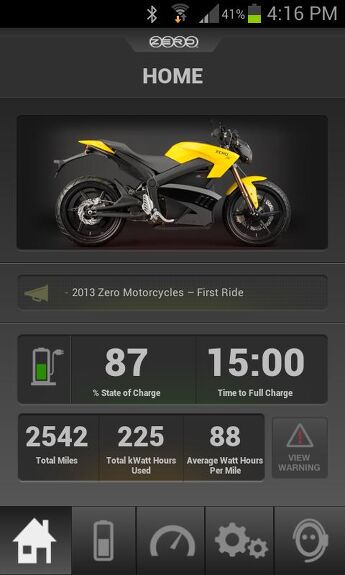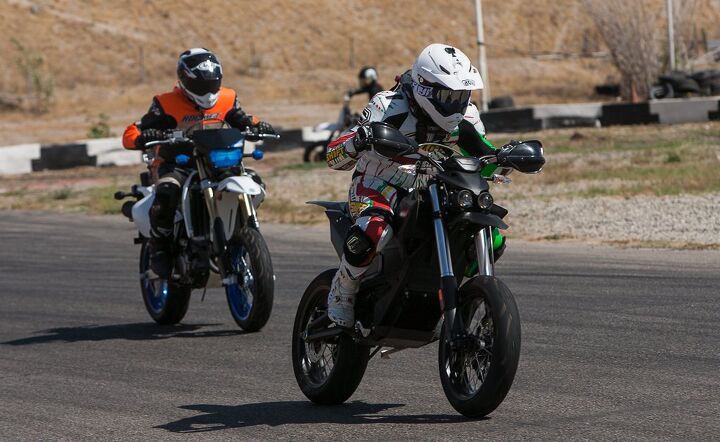Electric Vs. Gas Supermoto Shootout
Suzuki DR-Z400SM or Zero FX; which one makes the better supermoto bike?
Monumental! That’s what this is. MO’s first electric vs. gas, head-to-head supermoto comparison. A bare-knuckle brawl between the embedded establishment and the harbinger of an electrified future. Yep, this shootout is unique, but it’s also the proverbial tip of the iceberg. With the exponential rate at which electric motorcycle technology is improving, there’s a heap load more of this kind of comparison to come.
While we’ve ridden just about every consumer available electric motorcycle currently on the market ( Brammo, Energica, Lightning, Zero) these have either been single bike reviews or a shootout pitting one electric against another ( 2013 Brammo Empulse R Vs Zero S). Only once have we compared an e-bike to an internal-combustion engine (ICE) motorcycle.
Gas vs. Electric Dual-Sport Shootout: Yamaha WR250R vs. Zero DS
This is, therefore, an historical report, to be regarded by future generations, living in a world of depleted fossil fuels, as laughable. But for us in the here and now, residing through this slow-grinding transitional period – from cheap dinosaur power and deficient battery proficiency to the demise of OPEC and the world domination of Duracell – these types of shootouts are about to become commonplace.
The preparation of these two bikes for battle upon both the pavement and dirt of Adams Motorsports Park in Riverside, CA, could be construed as enough evidence to choose the winner of this bout. For the Suzuki DR-Z400SM, we removed the mirrors, taped the lights and blinkers, and stiffened the suspension. Cost of preparation: zero dollars. The FX, on the other hand, took a little more massaging both mechanically and financially.
About $3k worth of massaging, actually. The supermoto kit for the FX includes custom wire wheels with powdercoated Excel rims, all the necessary braking hardware, including the brake caliper adapter for the larger front rotor, and Conti Attack SM tires. “We also offer a kit with cast wheels (from a Zero S/SR) and all the previously mentioned hardware and tires for $1,500,” says Harlan Flagg, owner of Hollywood Electrics and the man responsible for outfitting the Zero FX in supermoto drag. The shock fitted to our bike adds another $700.
Having divulged the set-up disparity, let’s continue with retail pricing. This should allow those who are either disinterested in, or unaffected by, price to continue reading after finishing the next paragraph, while providing the cost/benefit bean counters with an early escape from the story.
2014 Electric vs. Gas Supermoto Shootout Scorecard | ||
|---|---|---|
| Category | Suzuki DR-Z400SM | Zero FX |
| Price | 100% | 0.0% |
| Weight | 52.5% | 100% |
| Engine | 80.0% | 70.0% |
| Transmission/Clutch | 82.5% | 100.0% |
| Handling | 73.8% | 100% |
| Brakes | 77.5% | 86.3% |
| Suspension | 76.3% | 81.3% |
| Technologies | 0.0% | 72.5% |
| Instruments | 80.0% | 80.0% |
| Ergonomics/Comfort | 72.5% | 77.5% |
| Appearance | 90.0% | 90.0% |
| Cool Factor | 75.0% | 77.5% |
| Grin Factor | 70.0% | 86.3% |
| Overall Score | 73.8% | 80.6% |
| Price and weight are scored based on objective metrics. Other scores are listed as a percentage of editors’ ratings in each category. The Engine category is double-weighted, so the Overall Score is not a total of the displayed percentages but, rather, a percentage of the weighted aggregate raw score. | ||
At $11,990 for a 2014 Zero FX ZF5.7, plus $3k for the supermoto kit, you could buy two 2014 Suzuki DR-Z400SMs at $7189 a piece and still have $612 left over. Anyone still reading? Bueller…? For those who managed to stomach the sticker shock, your reward is not having to wait to the end of this shootout to know which bike wins.
“If money were no issue and I were looking for a supermoto toy, I’d pick the Zero,” says Richie Rich Editor, Troy Siahaan.
Even though the Zero received a goose egg in the Price category of our ScoreCard due to its extravagant cost, it still managed to out-point the Suzook by a sizable 6.61%. How? Well, the DR-Z matched the Zero’s zero with a zero of its own in the Technology category.
Where the FX (and all Zeros, for that matter) have a handy and cool smartphone app for tuning the bike’s performance, checking its performance statistics, contacting Zero’s motorcycle support web page, etc., the DR-Z’s got nothing. No ABS, no TC, no ride modes, no smart phone app, not even EFI – the damn thing’s fed with a carburetor for chrissake!
The Suzuki bested the Zero in the Engine category, and managed to tie the FX in a couple others, but Engine and Price were the only two categories the DR-Z were able to win. Had the Zero’s motor not overheated after three laps it would have won the engine category, because for those three laps it was easily the fastest bike on the track.
“When it was running optimally, the acceleration was out of this world,” says Siahaan. “Even when it’s hot, power is decent, just power application is slower than normal.”
It’s possible that if we backed off the amount of regenerative braking and/or reduced the torque output from maximum to 80% we may have prolonged the engine’s performance. So, although the Zero’s engine was punished in the ScoreCard, we cut it a little slack because in normal operation you don’t ride around with the throttle pinned everywhere you go.
Suzuki DR-Z400SM
“The DRZ is a wholly capable motorcycle, albeit in stock form it isn’t very exciting,” says Siahaan. “Luckily, the aftermarket is full of tips and tricks to get maximum performance out of one.
“If it were my bike,” Troy continues, “I’d immediately upgrade the brakes, install a quick-turn throttle, fit better tires, slap on a less restrictive exhaust, and jet the carb appropriately. I think these simple upgrades would be a good start for real performance riding that would provide dramatic results. Since our Zero was lightly modified (though nothing in the performance dept.), I’d be interested in lightly massaging our DRZ and having a rematch!”
Siahaan’s statement pretty much sums up the DR-Z SM, which has gone largely unchanged since its introduction in 2005. In its white/blue livery it’s certainly an attractive Suzuki (especially those blue anodized aluminum RK Excel rims). But although it’s substantially less than the Zero FX, the SM is a comparatively expensive 400cc motorcycle. Honda’s CB500X is $690 less costly, while its NC700X a mere $610 more expensive.
But, like Siahaan writes in his single bike review of the Suzuki SM, when it comes to out-of-box, street-legal supermotos, the DR-Z is the only game in town.
Like its DR-Z400S stablemate – the SM’s dual-purpose alter ego – we’d prefer it if both bikes were equipped with a six-speed transmission, instead of the five. “Southern California highways and their common 80-mph flow of traffic (when traffic is flowing) is a little much for the DR-Z. The engine is spinning quite fast to keep that pace which makes for a buzzy experience. At 65 mph and under, the single-cylinder engine thumps along at a tolerable cadence. A sixth cog in the DR-Z’s transmission would go a long way in making the DR-Z a better freeway machine,” we said in the 2012 review.
Zero FX ZF5.7
As stated above, the cost of purchasing a Zero is prohibitive, but according to Harlan Flagg, business at his electric-only dealership is brisk. Harlan’s an enthusiast, fielding a team and competing in the first ever production electric motorcycle class at Pikes Peak last year ( of which our Troy Siahaan was one of the team’s riders). However, Flagg isn’t solely responsible for Zero’s fortunes, and the OEM appears to be growing, so regardless of the bike’s price tag, people do see the advantage of owning an electric motorcycle and are buying enough to keep Zero in the black.
“Price aside, its suspension was a weak point, though it’s only a hindrance when pushing to the max,” says Siahaan.
A couple points of contention neither the ScoreCard nor our day at the track takes into consideration is charging time or range. According to Zero the ZF5.7 can travel approximately 70 city miles, 44 highway miles at 55 mph, and 30 highway miles at 70 mph. Charge time from empty to full from a regular 110-watt wall socket is nearly 8 hours via the FX’s 650-watt/hour onboard charger. Times drop to 3.3 hours with Zero’s accessory Quick 2X charger, while a CHAdeMO station (if you’re lucky to have one nearby) reduces charge time to 1.5 hours.
Comparatively, you can fill the DR-Z’s 2.6-gallon fuel tank in about a minute and get an average of 47 mpg, making its range approximately 125 miles.
On the other hand, there’s really no maintenance with the Zero; no oil changes, no valve adjustments, etc., just tire pressure and brakes, really. So there’s that to consider when it comes to long-term ownership.
When the price of technology deflates to the point of equalizing the MSRPs of electric and ICE motorcycles, we will have reached the peak of oil’s significance. Until that moment we are left weighing the advantages and disadvantages of electric vs. gas. But in this case, as a fun track day supermoto machine, we’re leaning on the side of the electric bike, despite its exorbitant initial investment.
Check our gallery for more photos of the Suzuki DR-Z400SM against the Zero FX
For the gearhead, the tinkerer, the garage mechanic looking for a new challenge, Siahaan adds this perspective: “The upgrade path for an ICE bike has already been traveled many times. With the Zero, and any other electric bike, for that matter, the possibilities are new, exciting and endless. Similar to the early days of gas engines, where pioneers were experimenting with different ways to make more power, these are the early days of electric propulsion, and the myriad of different tips and tricks to make one of these go faster, longer, is still in its infancy.”
A former Motorcycle.com staffer who has gone on to greener pastures, Tom Roderick still can't get the motorcycle bug out of his system. And honestly, we still miss having him around. Tom is now a regular freelance writer and tester for Motorcycle.com when his schedule allows, and his experience, riding ability, writing talent, and quick wit are still a joy to have – even if we don't get to experience it as much as we used to.
More by Tom Roderick














































Comments
Join the conversation
One of the attraction of supermoto is backing it in to corners. How well does the Zero do in that regard? As easy as an ICE?
Specifically, can you dial in enough engine brake to work with the rear brake to control wheel speed during slides or even mimic the function of a slipper clutch?
UPDATE ON THE ABOVE, THINGS HAVE CHANGED, at least on one side.
1) THEN, 2014: "At $11,990 for a 2014 Zero FX ZF5.7, plus $3k for the supermoto kit, you could buy two 2014 Suzuki DR-Z400SMs at $7189 a piece and still have $612 left over".
Difference then = $7,801
2) NOW, 2016: $10,990 for a 2016 ZERO FXS ZF6.5 vs 2016 Suzuki DR-Z400SM at $7,189
Difference now = $3,801
Plus the capacity in kWh for the Zero has increased 10%, from 5.7 to 6.3 kWh.
Progress indeed....I wonder how the above compari$on will look 2 years from now....